By technical editor Matt Allard:
Sony a7S/ Atomos Shogun 4K And HD Test from Matthew Allard ACS on Vimeo.
The Atomos Shogun was one of the most anticipated video products of 2014. The 4K external recorder was announced at the NAB show way back in April. Units finally started to ship just before Christmas and it has been a long and patient wait for customers to get their hands on one.
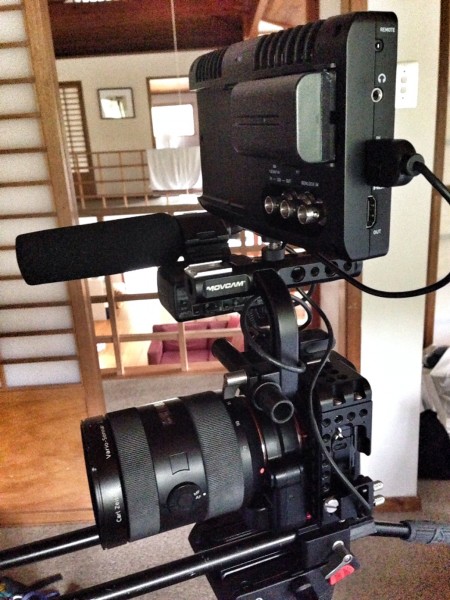
I have had a production unit on loan from Atomos for almost a week and had the chance to really put it through its paces. Over that time I have run various tests, shown the unit to some well respected cinematographers and been able to gain an overall opinion about the Shogun. I have also interviewed Atomos CEO Jeromy Young to get his responses on what I and other users thought could be improved.
The image quality when shooting 4K with the Sony a7S
As soon as I got the Shogun I shot and posted a piece in 4K with the Sony a7S at Pearl Beach , north of Sydney. In full frame mode there is a little more noise in the images compared to what you get in HD but that is to be expected. I discovered after examining the recorded footage is that there is inherently more noise when you record 4K in the cameras APS-C crop mode. This has nothing to do with the Shogun – it is just recording the output of the camera’s HDMI. It is certainly something to be aware of though if you plan on shooting in low light conditions in 4K.
I would recommend trying to avoid shooting in the APS-C crop mode and stick to the full frame mode if you have suitable lenses. When you record 4K in APS-C mode the camera isn’t using the full sensor so it has to upscale the image to 4K. I think it holds up reasonably well at lower ISOs but as you go into the higher ISO values noise is much more apparent. Below are some high ISO tests comparing how the camera looks in 4K full frame and APS-C mode, as well as in the same modes downsampled to 1080 HD for comparison. Downloading of the files is recommended as Vimeo’s compression masks the differences.
I also did several tests to compare the resolution of images in 4K and HD, in both full frame and APS-C modes. As expected the 4K image is a lot more detailed than the HD. This is quite evident when I cropping in on the image 200%.
Interestingly putting a 4K image onto a HD timeline and exporting it as 1080 provides a lot more detail and sharpness than the same image recorded natively in HD. For people wanting to shoot 4K but deliver in HD this is good news. I see a lot of users of the Shogun going the route of acquiring in 4K, but delivering in HD. The Shogun and a7S will deliver good results.
Using the Shogun
The Shogun is quite straight forward to use and has an intuitive interface. Anyone who has previously used a Atomos Samurai or Ninja Blade recorder will be instantly familiar with most features. Setting the Shogun up with the Sony a7S was as easy as connecting the HDMI cable, enabling the 4K HDMI setting on the camera and turning on the unit. The Shogun automatically detects the 4K signal from the camera and you are all set to shoot. The only thing left to do is select what flavour of ProRes you want to record in. I really like the ability to choose between ProRes LT, 422 or 422 HQ. In 422HQ with a 480GB SSD you can record around 1hour and 20min of 4K footage. For a lot of users ProRes 422 will be more than enough. One thing to note when you use the HDMI out with the a7S is that you cannot record internally on the camera at the same time as recording to the Shogun.
The touchscreen interface is easy to use and all the familiar features like peaking, zebras, false colour etc. are there. Nice new include the 1:1 and 2:1 pixel zoom for focus check – that enables you to drag your finger around in a small box to zoom in and check sharpness anywhere on the screen. This is important as it is very critical to get exact focus when shooting 4K. I won’t go into details about the menu system as we previously covered it here.
For now you can’t play back your images on the recorder itself – although this is promised in a firmware update imminently. Once you have finished recording you take out the SSD or HDD and hook it up to your computer with the supplied dock. You are then ready to view or edit your files straight away. The beauty of ProRes recordings is that they are universally accepted and easily read by almost any modern computer and video editing package.
Build Quality
Judging build quality is always difficult. Just because something feels solid or flimsy doesn’t necessarily mean it is built to last. You need to take into account what is the product designed to do and will it work in that environment without breaking. The Shogun does feel a little less solid than previous Samurai and Ninja Blade. It doesn’t have the same metal frame encasing the recorder. Atomos have obviously chosen the plastic they use to keep weight and heat down, and maybe manufacturing costs too. How the unit would hold up if you dropped it is something I’m not going to test deliberately, but I doubt it would fare well.
The screen is made out of a Gorilla glass type material but it is not the latest type and will shatter if you drop it. That said you wouldn’t drop a lens or a camera and expect it to fare well – equally expect the same with the Shogun. Mounted on a camera or gimbal etc. I don’t see too many problems with the build quality and it is similar in construction to many camera top monitors that people use every day. If you are really worried about knocks and drops then I’m sure it won’t be long before accessory makers will have light weight cages to encase the Shogun.
What concerns me more are the HDMI inputs. There is no HDMI port protection on the recorder and the HDMI connector sticks straight out of the side of the Shogun. This is a potential problem as cables are usually the things that get caught if your moving through tight spaces. I would have preferred to see the HDMI ports placed on the back of the unit, or at very least a right angle HDMI cable included. As far as weather sealing goes, there really isn’t any. I would not recommend using the Shogun in the rain or snow without a protective cover. The big heat vents located on the unit are completely exposed so any type of liquid that gets in there is going to cause problems. Obviously covering the vents with a rain shield may also cause heat issues – I’m not sure what I would do in wet tropical conditions. Just how robust and reliable the Shogun proves over time we will have to wait and see.
The Screen
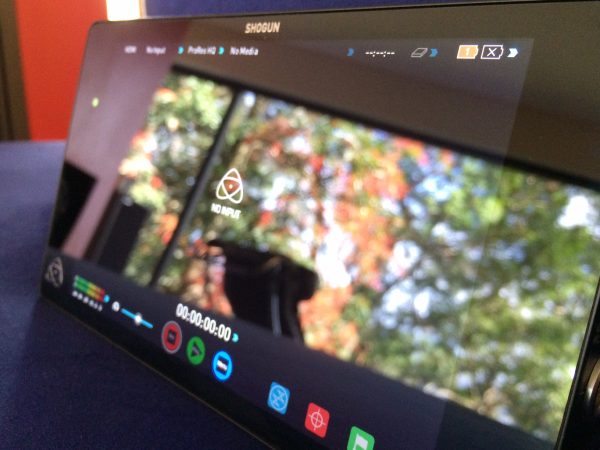
The screen is one of the Shoguns strengths. With a full 1920×1080 display it has nice colour reproduction and produces a pleasing image. It is quite bright but don’t expect to be able to use it in bright/sunny conditions outdoors without a hood. It is very reflective so when you look at it from certain angles it can be hard to see. If getting a Shogun I think I would add a matte screen protector like the type you can buy for your iPad. You will also need to carry a cleaning cloth around as the touch screen operation means you will be constantly wiping your finger print smudges off the screen. There is an Atomos sun hood coming and you can find out more information by listening to the interview with CEO Jeromy Young in this post.
Size And Weight
Despite the 7″ screen the Shogun doesn’t feel to big when used in combination with the a7S or GH4. Atomos have done a good job of keeping the unit as compact and light weight as possible. This is very important if your going to be using it on small rigs or cameras. I mounted the Shogun on top of my Movcam a7S rig and even hand holding the camera, the added weight of the Shogun never made it feel like the camera operation was impeded by having the unit attached.
Battery Life
The decision for Atomos to go with one battery instead of the original 2 that we saw at NAB was purely to cut down weight and try and streamline the unit. Unfortunately the battery life is pretty poor using the standard batteries. Using an included battery the Shogun will only last between 30 to 40minutes. Thankfully Atomos do give you other power options – an included dummy battery with a D-tap and an auxiliary power jack allow you to power it externally. You could also use the Atomos power bar that will fit below or above the Shogun. My concern here is that if you want to cut the weight of the Shogun down by only having one battery it sort of defeats the purpose of having to use another power source mounted to your rig instead. This is fine if you are using larger cameras but if your using it with small cameras like the a7S or GH4 most users won’t want to run a separate power source. Another solution will be to use larger Sony NPF type batteries like those used in the FS700 and 100 – but these again add weight and bulk to the rear of the recorder.
The other thing I would like to see changed is the battery indicator. The Shogun battery indicator goes from green to red and then flashing red. You get very little warning and then the Shogun just turns itself off. I am not a fan of battery indicators that don’t show you the exact time or percentage remaining. Jeromy Young’s response to the battery issue is also in the interview I did with him later in this article.
Audio
The added lemo connector which combines 2 XLR audio inputs and 2 XLR outputs is a great concept provides a good selection of audio recording options. Phantom power is available to power you microphone and headphone monitoring is provided too.
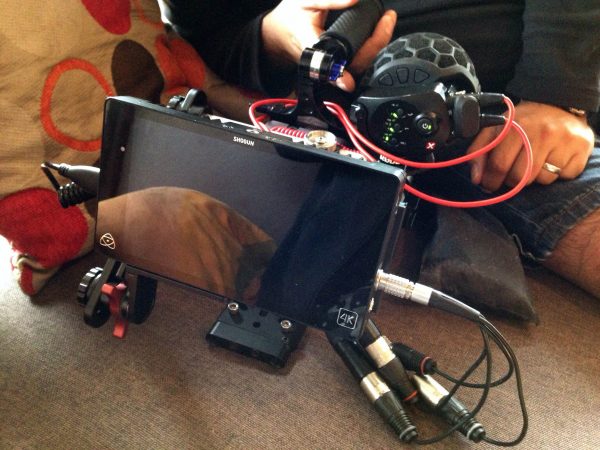
On the downside once you connect two XLRs cables to the connector you end up with a lot of cable weight dangling in the air. Just like the HDMI cable, it sticks straight out on the side of the unit and because of its weight it does tend to pull the Shogun slightly to one side. I’m being very picky here but again it is something where the design could be improved.
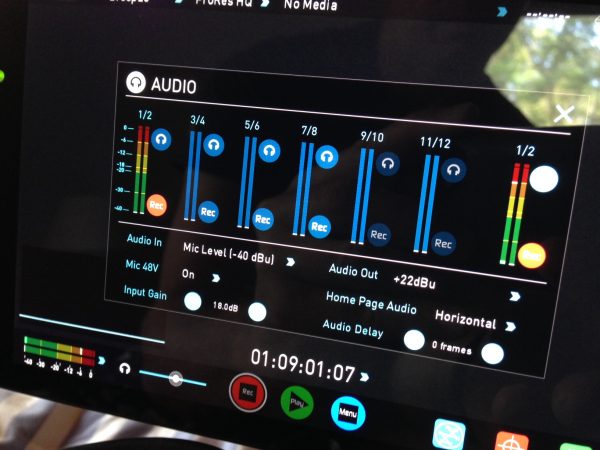
Another thing I found quite strange is that when you have two channels of audio going into the Shogun you cannot adjust the level of each individual channel. Any adjustment you make alters both channels – somewhat useless if you have two different audio sources with different output levels such as an XLR top mic and a wireless pack. I have brought this up with Atomos and they are going to look into it.
Included Accessories
You can’t say Atomos doesn’t give you value for money. Included with the Shogun are a lot of accessories. Again we have covered them here so I won’t go into too much detail. All the accessories are great and the HPRC case is a nice touch, but the biggest thing missing for me was the sun hood. Apart from the SmallHD DP7 and Transvideo high brightness monitors, I find it very difficult to use most screens outdoors in sunny conditions. The Shogun is no different. Why manufacturers don’t just give you one of these in the box is a mystery to me as they are essential.
What other professionals thought
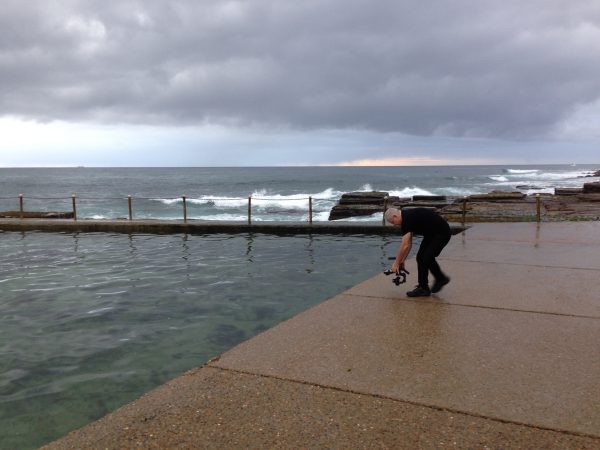
We got three respected cinematographers to use the Shogun on a real world shoot. Jason Wingrove, Peter Barta, and Clinton Harn came along pre dawn to one of the rock pools in Sydney. Here we had a chance to use the use the Shogun on the a7S and also try it out in combination with the Nebula4000 Lite 3-Axis brushless gimbal. Jason Wingrove has modified the Nebula so it looks more like a traditional gimbal and can take a monitor. The Shogun easily mounted onto the Nebula and Jason was impressed with just how easy it was to use. He liked the ability of being able to press the record button directly on the Shogun and not have to fiddle around and try and find the fiddly record button on the a7S.
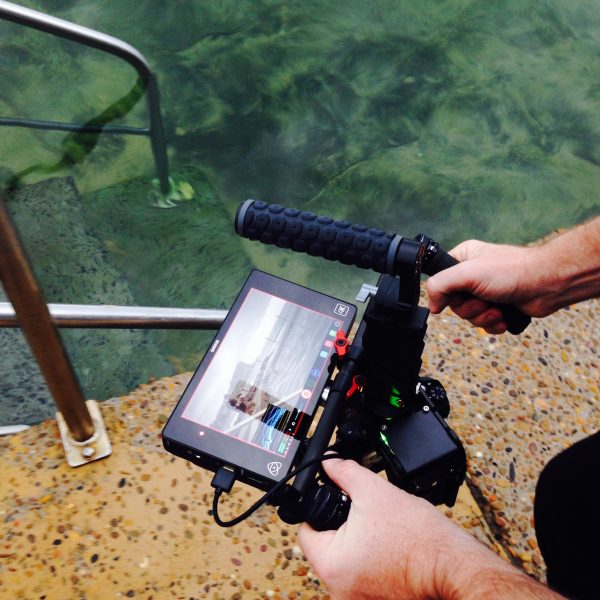
The Shogun looks to be a good option if your using a gimbal or other stabilising device – especially as you are likely to need an external monitor anyway. What Jason, Peter and Clinton all thought could be improved was the way the focus peaking works. Shooting in S-Log, wide open with low contrast lenses it was very hard to get any sort of peaking visible, making it difficult to focus. We could have used the pixel zoom but then you need to go into a menu and this isn’t always practical – especially on a gimbal. They unanimously said the intensity of peaking needs to be able to be adjusted.
All the guys also commented that they thought the HDMI connector should of been mounted on the back and not on the side of the unit. All of them were equally puzzled as to why the Shogun used a lemo connector for the audio, but not for the power. They also were as unimpressed as me by the battery life. Jason thought it was strange that when the unit ran out of battery and a recording was interrupted, upon powering the unit back up you get a “A broken file has been detected. Do you want to recover it?” message appearing on screen. He made the point that there were no circumstances where you wouldn’t want the video file recovered and this should be done automatically. Personally I didn’t mind that warning – at least I know it has happened.
Despite making some criticisms all three cinematographers were impressed by the Shogun. They liked the screen, the recording options and the size. All of them commented that it was pretty amazing how far technology has come and that you could now record 4K over HDMI from a very small camera setup.
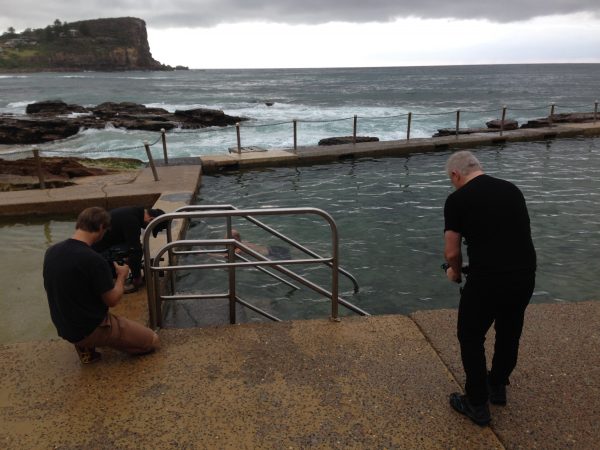
Conclusions
I can only judge the Shogun from my short time using it. So far this is my assessment.
The Shogun gives you a lot of bang for your buck. It’s easy to use and takes cameras like the GH4 and a7S to another level. It has a nice screen, great recording capabilities, a lot of included accessories and an intuitive operating system. I didn’t encounter any problems with anything I recorded and even when the unit ran out of battery and shut down while i was recording, I never lost a file. The use of off the shelf media is always going to be a small gamble. There will always be defective hard drives that get to market. If Atomos used expensive proprietary media then people would complain about the cost. Atomos know their what their customers want and so have avoided using expensive proprietary media. The cost outweighs the small risk of a defective drive.
There are things that i think could be improved such as the battery life, HDMI placement and a few small things that should be in the operating system. We are still waiting for the 3D LUT capability and playback. Sadly, like most devices that come out these days, firmware seems to be an on going process. As a Sony F55 owner I’m well aware of how long it can take to perfect the firmware.
Atomos CEO Jeromy Young agreed to talk to me about all the issues that our review bought up. You can listen to that interview below as he responds to users feedback:
[soundcloud url=”https://api.soundcloud.com/tracks/183763741″ params=”auto_play=false&hide_related=false&show_comments=true&show_user=true&show_reposts=false&visual=true” width=”100%” height=”600″ iframe=”true” /]
Overall the Shogun ticks a lot of boxes and I think most users will be very happy with it. At the end of the day the Shogun delivers what it promises – 4K recording on a budget, a great screen and easy to use interface. We did do some tests with the GH4 and the results were equally impressive. The Shogun can be used with just about any camera out there on the market to record either HD or 4K depending on what your camera can output. The versatility the Shogun is that you can use it not only a recorder, but a very good monitor too.
Atomos have always provided free firmware and I am sure future firmware will help improve the unit over time – they did the same with the Ninja and Samurai models. Atomos has always been a company that tries to learn from their mistakes so it will be interesting to see what improvements can be made after they receive customer feedback. Being able to record 4K over HDMI is an incredible feature and something up till now was extremely hard to do out in the field. The Shogun has a lot to live up to as the hype surrounding its announcement was huge. How it performs over time in users hands is something we will have to wait to see.





